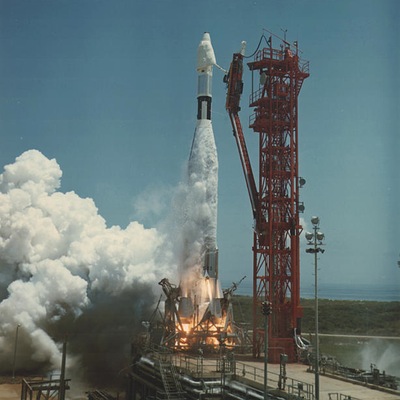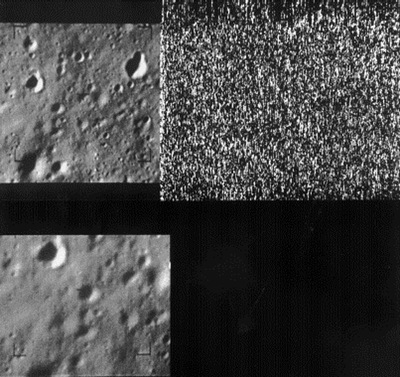Ranger: America’s first successful lunar program<< page 1: dealing with failure Success at last!By the summer of 1964, Ranger B had been modified and was ready to be launched during the next launch window in late July. There were some who wanted to target Ranger B close to the impact point of Ranger 6 to observe the crater it produced. Unfortunately, the trajectory constraints of this launch window would not allow an impact that far east. Instead, several targets were considered for the first day of the launch period on July 27 along seven degrees west longitude between 21 degrees north and 14 degrees south latitude. The launch on this first day was scrubbed due to problems with the ground-based portion of the guidance system. Finally, on July 28, Ranger 7 successfully lifted off only 7.9 seconds into its launch window aimed at 11 degrees south, 21 degrees west in the northwest portion of Mare Nubium.
With a good injection burn from the Agena B, it was calculated that Ranger 7 would skim over the leading edge of the Moon and impact on its far side. A 50-second course correction burn the day after launch brought the predicted impact point within the intended target area. When Ranger 7 was 2,277 kilometers (1,415 miles) above the lunar surface traveling at 1,917 meters per second (4,290 miles per hour), the F chain cameras were placed into the ninety-second warm-up mode followed later by the P chain. Much to the relief of JPL and NASA officials, pictures from the F chain cameras started streaming back to Earth seventeen minutes and thirteen seconds before impact, followed three minutes and 33 seconds later by the P chain. By the time Ranger 7 plowed into the lunar surface 68 hours, 35 minutes, and 42 seconds after launch, 4,316 pictures had been transmitted back to Earth. The last image, only a portion of which was transmitted before the probe’s destruction, was acquired at an altitude of only 300 meters (1,000 feet), showing features as small as one meter (three feet) across. Ranger 7 had impacted at 10.7 degrees south, 20.7 degrees west, only 13 kilometers (8 miles) from its aim point. It was the first major American lunar mission success after almost six years of attempts. The pictures returned by Ranger 7 confirmed that the lunar mare regions are quite smooth and apparently free of major hazards for the Apollo Lunar Module. Because of the size and shape of the craters and the topography observed during the approach, it seemed unlikely that the lunar surface was coated with a deep dust layer that could bury a lunar lander upon touchdown, as some had feared. The next mission, Ranger 8, was successfully launched on February 17, 1965. Like its predecessors, it was targeted for the most promising class of Apollo landing sites: the smooth equatorial mare regions. For this mission, the selected aim point was 3 degrees north, 24 degrees east in Mare Tranquillitatis, about 210 kilometers (130 miles) south of the impact point of the unsuccessful Ranger 6. After injection into a translunar trajectory, tracking indicated that Ranger 8 would miss the Moon by 1,828 kilometers (1,136 miles). This was negated by a 59-second mid-course correction burn at a distance of 159,743 kilometers (99,281 miles) from the Earth. During the burn, however, controllers were alarmed by a loss of telemetry from the receding spacecraft. Concerned about attempting any more maneuvers, it was decided that Ranger 8 would not perform the terminal descent maneuver to align Ranger’s cameras with its flight path. While this slightly angled viewing geometry would smear the last few images returned by the quickly descending probe, it did offer the opportunity to take a swath of images over a wider area that would partially overlap with the earliest images returned by the previous Ranger 7 mission. Stereo images would also be procured in the process. As the probe approached the Moon, the cameras were turned on 23 minutes before impact, almost ten minutes before normally planned. The resolution of these first images was comparable with the best Earth-based telescopic photographs. As Ranger 8 hurtled towards its destruction, the robot craft continued returning a stream of pictures that were very similar to those returned by the previous probe. The maria all seemed to have similar topography and presented no major problems for a landing, human or otherwise. Ranger 8 then crashed into the Moon, producing a 14-meter (45-foot) diameter crater at 2.59 degrees north, 24.77 degrees east, only 23 kilometers (14 miles) southeast from its aim point. Ranger 8 returned a total of 7,137 pictures, the best of which showed features as small as 1.5 meters (5 feet) across. The American lunar program finally seemed to be on the road to success.
By mid-March 1965, the last Block III Ranger spacecraft was being prepared for launch. Unlike its sisters, Ranger D was going to be targeted for more scientifically interesting sites. The first two days of the lunar launch window did not offer any promising targets and no launch attempts were made. A launch on March 21 would allow an impact in the crater Alphonsus, which had shown some signs of outgassing hinting at geologic activity in the recent past. A March 22 launch would land in the bright rayed crater Copernicus. March 23 would allow Kepler to be targeted, while a launch on either March 24 or 25 would permit an impact near Schroter’s Valley, a sinuous rille formed by volcanic activity. As it turned out, Ranger 9 lifted off on its first attempt on March 21, bound for a point at 13 degrees south, 2.5 degrees west, located in the crater Alphonsus. After Agena 6007 completed its ninety-second injection burn, Ranger 9 was heading for a point only 640 kilometers (400 miles) north of its target. A 31-second burn of the course correction engine 38 hours, 26 minutes after launch added the 18.1 meters per second (40.6 miles per hour) needed to put Ranger 9 back on course.
As the last Ranger was hurtling towards the Moon, the probe aligned its cameras with its flight path. Twenty minutes before impact, controllers sent commands to begin warming the cameras. Starting at an altitude of 2,100 kilometers (1,300 miles), Ranger 9 began transmitting the first of 5,814 pictures. The resolution steadily increased to as good as 25 centimeters (10 inches) before the spacecraft slammed into the floor of Alphonsus at 13.3 degrees south, 3.0 degrees west, only 6.5 kilometers (4.0 miles) from its target. Surprisingly, the images returned by Ranger 9 indicated that while the lunar highlands were rougher than the maria, they were still smooth enough to be considered viable landing sites for future lunar landing missions. Tracking of all four Block III Rangers also indicated that the Moon’s geometric center was displaced from its gravitational center. This fact helped to improve the navigational accuracy of future lunar missions. After six years of effort, a total of $267 million in funding (about two billion of today’s dollars), much heartache over six failures, and much relief on three eventual successes, NASA’s first major lunar exploration program was over. Efforts now turned to the other two legs of NASA’s unmanned lunar triad, Surveyor and Lunar Orbiter. BibliographyR. Cargill Hall, Lunar Impact: The NASA History of Project Ranger, Dover Publishing, 2010 Raymond L. Heacock, “Ranger: Its Mission and Its Results”, TRW Spacelog, Summer 1965 Michael M. Mirabito, The Exploration of Outer Space with Cameras, McFarland, 1983 H. M. Schurmeier, R. L. Heacock, and A. E. Wolf, “The Ranger Missions to the Moon”, Scientific American, January 1966 Paolo Ulivi with David M. Harland, Lunar Exploration: Human Pioneers and Robotic Surveyors, Springer-Praxis, 2004 Home |
|

